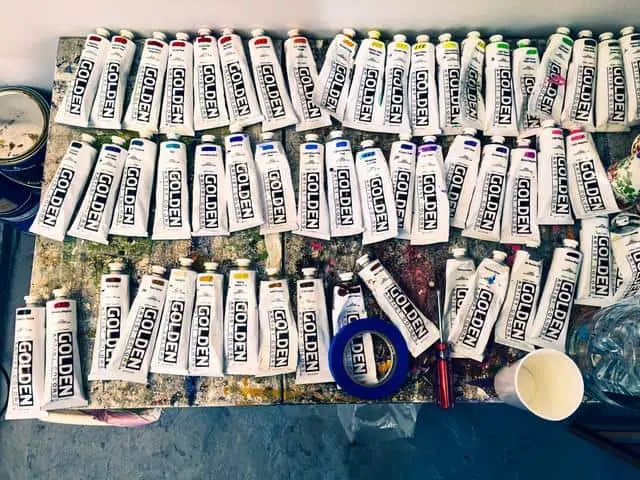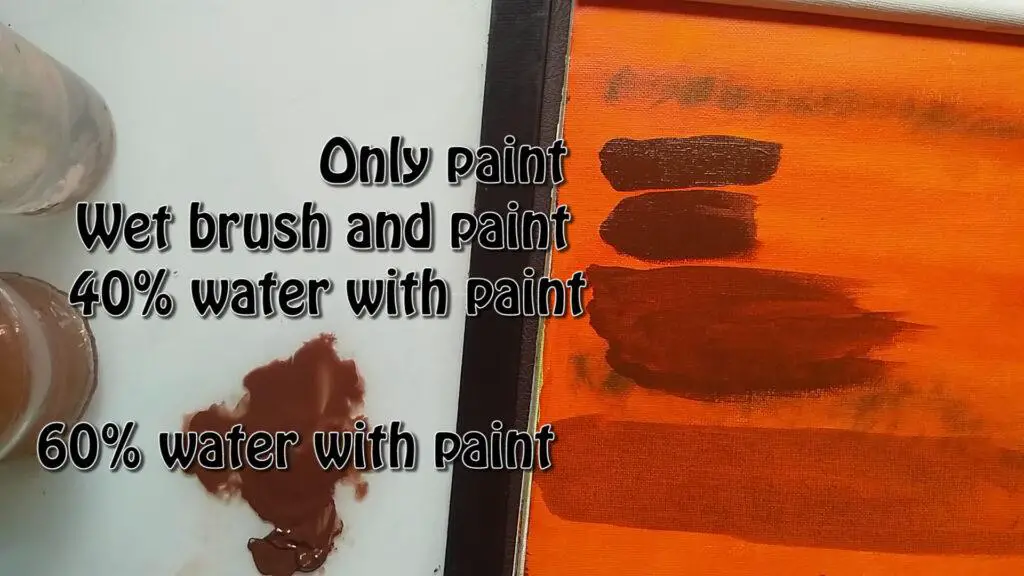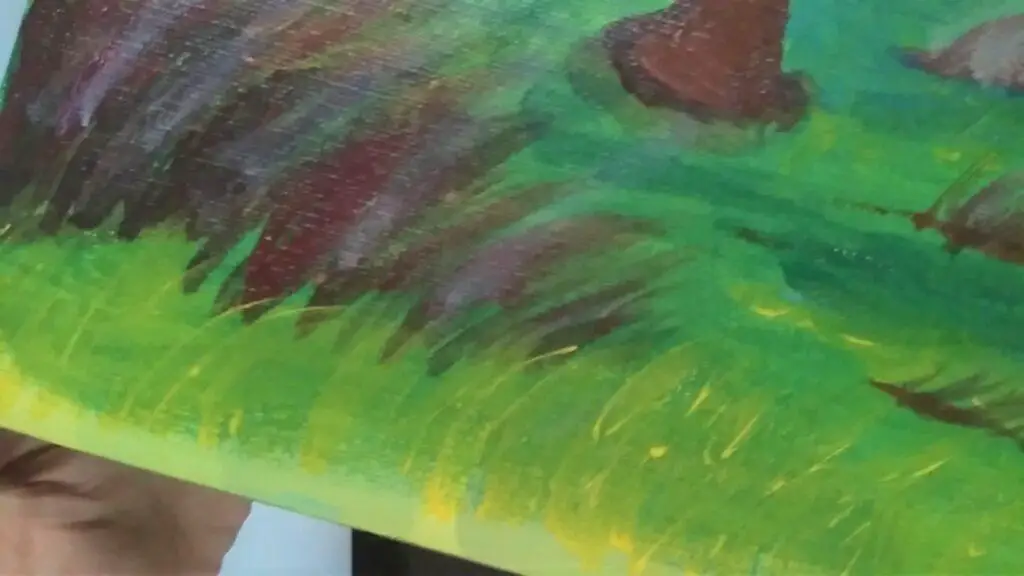You might have seen some acrylic painting artists do some really good layering. Each layer has a good covering and is not transparent. If your want to cover the paint layers with acrylic paint, there are some neat things you need to follow.
Acrylic paint does not cover well when there is less concentration of pigment or transparent pigments. These can be fixed by using artist-quality paint instead of low-quality paint, mixing with opaque colors such as titanium white, and using opaque pigments instead of transparent pigments in acrylic paints.
Having opaque acrylic paint that covers well in your palette can increase the vibrancy of your painting and make painting much easier. If your acrylic painting does not cover well, there are only a few things that you need to fix.
Using low-quality acrylic paint
Low-quality craft or student-grade acrylic paint has less pigment concentration and more fillers. Meaning it will take many layers of paint to cover what is underneath the paint. It is especially true with lighter colors like yellow and white. This is not a problem with artist-quality acrylic paint.
How to fix:
If using student grade or cheaper paint use less or no water. Sometimes you need to be patient and let the colors dry first and add another layer of the same color. This can be annoying when painting over darker colors, especially when painting an eye or water that has lighter highlights.
Artist-quality acrylics have high pigment concentration and fewer fillers. Also, they are denser than cheap paints. So it covers well. You can also mix artist-quality titanium white with low-quality paint. As artist quality titanium white is highly pigmented, it will cover better.
When using artist-quality paints you need to pay attention to how much water you are using. Otherwise, one section with cheap paints will look like watercolor and denser look with high-quality paint.

Using acrylic paint with a mixture of pigments
Some acrylic paints are made from a mixture of different pigments. You can find this information on the paint tube or the bottle. Each pigment has its unique code according to the color index. The color index was originally developed in America to identify pigments and dyes that are used in all kinds of paint. The color indexing system is now used internationally.
You can identify pigments in a tube of paint with the following codes and a number that come along with it according to the color index.
- PW = pigment white
- PY = pigment yellow
- PO = pigment orange
- PR = pigment red
- PB = pigment blue
- PV = pigment violet
- PG = pigment green
- PBr = pigment brown
- PBk = pigment black
The more pigments you see on the label, the less quality it will be and cheaper. You will not get that intensity of color you get with pure pigments. Thus the paint will be generally transparent and have less coverage.
This is especially a problem with yellow colors or other lighter colors. You will mostly get transparent yellow colors with pigment mixtures unlike buying paint with one pure pigment like cadmium yellow. There are many colors like yellow that are transparent and have less coverage.
How to fix:
Check if the paint has a part ‘hue’ at the end of the color name. Hue refers to a mixture of pigments. As an example, cadmium yellow medium hue means, this tube of paint does not have cadmium in it. But several nontoxic pigments are mixed to match the color of cadmium yellow medium making a more transparent color.
The solution will be to check the paint tube or bottle label well. Check the pigments of your paint. If there is only a single pigment, you are good to go. But if the paint has multiple pigments, then be cautious when choosing it. Check its opacity. If it is an opaque color with a mixture of pigments you are good to go.
But remember you can always mix your colors. Therefore focus on buying pure single pigmented colors and mix other colors yourself. This way you can buy opaque high-quality colors.
Using acrylic paint with transparent pigments
Sometimes the problem is not with the quality of paint, but rather with the type of pigment in the paint. There are both transparent and opaque pigments. You will need both of these pigments in paintings. Sometimes you need to cover what is underneath. Other times you will need to glaze it over with transparent paint.
I have researched the 2 best acrylic paint brands which are Golden and Liquitex, and summarized, what are their opaque, semi-opaque, semi-transparent, and transparent colors. I looked at both artist quality(Liquitex professionals) and student quality acrylic range of Liquitex (Liquitex Basics).
The following is what I have found. I have only included pure pigmented colors in the table. I did not include any pigment mixtures. It is always better to avoid pigment mixtures. Rather you can buy a few pure single pigmented colors and mix others by yourself.
How to fix:
If you want better coverage, make sure you choose from opaque or semi-opaque colors. As you can see, the same colors have different opacities with different brands. Be sure to check the label when you buy paint. Artist quality acrylics have their opacity indicated on the label.
Also with Liquitex basics, you can see there are only a few pure pigments, and I have included them all in the table. This is the reason why you need to avoid student or craft quality paint and go for artist quality acrylic paint. It will ensure better coverage of acrylic paint and make painting easier.
You can make the most transparent paint with artist-grade titanium white. It will make the paint opaque and give better coverage. Mixing any transparent color with opaque color will give the same results.
I have written a whole article about the 17 pros and cons of acrylic paint. You can find all the important aspects of acrylic paint there.
Thinning acrylic paint too much
You can get transparent paint and poor coverage when acrylic paint is thinned too much. This can happen with either water or acrylic mediums such as matte mediums, gloss mediums, or gels. Following is an image showing how your paint will look when thinned to extremes with water.

when adding 40% to 60% or above water, acrylic paint looks like a wash or a glaze and has a watercolor look. It does not cover the below layer of orange paint when mixed with too much water. The same happens with acrylic mediums. If added more than 25% of medium up to 80%, the paint will not cover at all. It will look like a glaze.
I wrote a whole article about using water with acrylic paint. It will tell you all about the different effects you can get just by changing the amount of water you are using.
How to fix:
So if you want better coverage, do not mix more than 25% water with acrylic paint. The less thin the paint is, the better coverage you will get. The 25% rule is mostly applicable to artist-quality paint. They have a very high pigment density compared to the student or craft-quality acrylic paint.
Because of this be cautious when mixing water or mediums with student or craft quality paint. Little to no water will improve coverage with low-quality paint. However, There is some low-quality paint that will not cover well, regardless of thinning down. Yellow is one example. The best thing, in this case, is painting multiple layers of the same color.
Not preparing the painting surface well

Preparing your canvas or the painting surface before painting is equally important as painting itself. If you do not prime your canvas well, acrylic paint will not spread smoothly across the canvas, Rather it will absorb into the canvas and will not cover the canvas surface well. There will not be a smooth paint application.
How to fix:
Make sure to prime the canvas before painting, even if the paint manufacturer said the canvas is pre-primed. Damages to the plastic cover on canvas can contaminate the canvas surface with grease and dust. It reduces the adhesion of paint to the canvas, Also the gesso may not be even on the surface when manufacturing.
When you buy a canvas from the store. First lightly sand it (if pre-primed) and apply 2 to 3 coats of gesso. Lightly sand between the coats. It will make a difference in the smooth application and coverage of paint on canvas.
If you are wondering how to prepare other unusual surfaces like glass, metal, wood, or plastic, I have a great article for you. Click the following link to access it: What will acrylic paint not stick to
Applying a single coat with transparent acrylic paints

If you have already decided that high-quality, artist-grade, expensive paints are not for you then you can go for cheaper options. These are usually student-grade or craft-grade paint. Generally, these paints have a very little amount of pigments and more fillers in them. Thus cheaper paints are usually transparent, especially when it comes to yellow or other lighter colors.
How to fix:
It will be really hard to cover a paint layer with low-quality paints. In these cases, you need to be patient. Apply one layer of transparent paint and wait until it dries. Then apply about 3 to 5 coats of layers of the same paint while allowing each layer to dry in between. This will cover the underline layer of colors at some point.
You can do this with high-quality transparent paints with transparent pigments as well.
I have written an article series about common acrylic paint questions and answers: part 1 and part 2. You can find answers to questions like this in the articles even before you face them.
Conclusion
Having acrylic paint that does not cover well is sometimes really annoying, especially when you don’t know the reasons why that happens. It is fairly easy to fix regardless of the type of acrylic paint you have, whether it be artist-grade, student-grade, or craft-quality paint. Generally, buying the most opaque paint and mixing transparent colors with opaque paints can solve this problem. However, the best option will be to buy artist-quality acrylics with the highest opacity.

